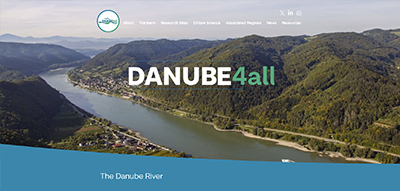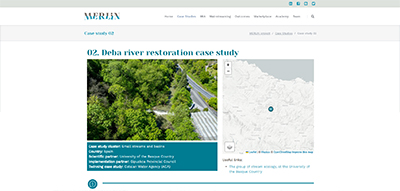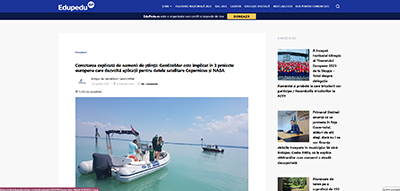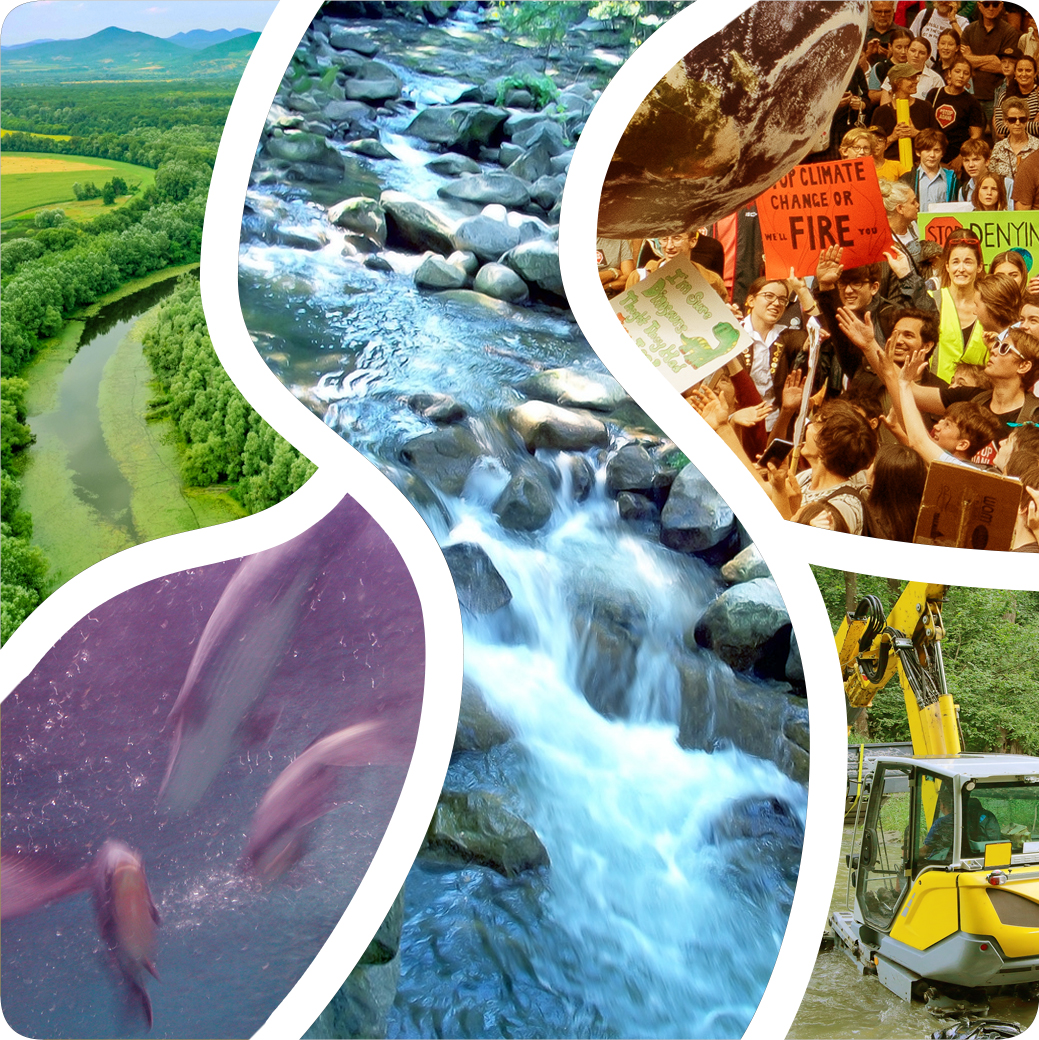Dr Albert Scrieciu
Coordinator of the Interdisciplinary research of the fluvial environment department - Romanian National Institute of Marine Geology and Geoecology - GeoEcoMar
NGOs & Civil Society

My Projects
 Horizon Europe projects DANUBE4all – Restoration of the Danube River Basin Waters for Ecosystems and People from Mountains to Coast.
Horizon Europe projects DANUBE4all – Restoration of the Danube River Basin Waters for Ecosystems and People from Mountains to Coast.
 H2020, MERLIN - Mainstreaming ecological restoration of freshwater - related ecosystems in a landscape context: innovation, upscaling and transformation
H2020, MERLIN - Mainstreaming ecological restoration of freshwater - related ecosystems in a landscape context: innovation, upscaling and transformation
H2020, NAIAD - NAture Insurance value: Assessment and Demonstration.
- Key project facts
All three projects - NAIAD, MERLIN, and DANUBE4all - focused on the restoration of freshwater-related ecosystems by improving ecological status and promoting biodiversity.
In NAIAD, we contributed to the design of nature-based solutions tailored to flood and drought risk reduction.
In MERLIN, we supported both conceptual development and field implementation, including a Romanian case study at Gârla Mare.
In DANUBE4all, restoration is being implemented in the Upper and Middle Danube, while in the Danube Delta, we are currently developing technical restoration solutions for future implementation.
H2020 – NAIAD (Nature Insurance Value: Assessment and Demonstration)
NAIAD aimed to assess and operationalize the insurance value of ecosystems to reduce flood and drought risks using nature-based solutions (NbS). It developed tools, methods, and business models tested across nine demonstration sites. The project emphasized stakeholder co-creation and integrated biophysical, social, and economic approaches.H2020 – MERLIN (Mainstreaming Ecological Restoration of Freshwater-Related Ecosystems)
MERLIN (2021–2026) promotes freshwater restoration through 17 large-scale demonstration projects across Europe. With 44 partners, MERLIN mainstreams NbS by engaging with economic sectors such as agriculture and navigation, and develops scalable strategies, educational resources, and monitoring frameworksHorizon Europe – DANUBE4all
DANUBE4all is a flagship Horizon Europe project (2023–2027) dedicated to restoring freshwater ecosystems within the Danube River Basin. The project supports the co-creation of a Danube River Basin Restoration Action Plan and implements pilot actions from mountains to coast. It focuses on hydrological and ecological connectivity and leverages nature-based solutions for systemic restoration.The projects aimed to restore natural habitats and improve the biodiversity.
In NAIAD, we contributed to the design of nature-based solutions tailored to flood and drought risk reduction.
In MERLIN, we supported both conceptual development and field implementation, including a Romanian case study at Gârla Mare.
In DANUBE4all, restoration is being implemented in the Upper and Middle Danube, while in the Danube Delta, we are currently developing technical restoration solutions for future implementation
- What impact did these projects have on biodiversity, if any?
We are still monitoring the effect on biodiversity, which will take time to develop. But the river habitats improved in a very short time and we expect increased biodiversity and increased movements of endangered fish species such as the European eel.
- What work challenges did you face and what approach did you take to solve them?
One of the main challenges was the integration of scientific knowledge across disciplines - hydrology, ecology, socio-economics - into actionable restoration strategies. To address this, we adopted a transdisciplinary approach, co-developing solutions with experts, practitioners, and stakeholders from the outset.
Another challenge was the lack of standardized indicators for evaluating restoration effectiveness and ecosystem services delivery. Through the MERLIN project, we contributed to developing a unified monitoring framework aligned with EU Green Deal and Biodiversity Strategy goals.
In NAIAD, we faced the difficulty of quantifying the “insurance value” of nature in a way that could be integrated into real-world water risk management decisions. This was overcome by co-designing methodologies with insurers, municipalities, and water authorities, and testing them in diverse European contexts.
Finally, in DANUBE4all, aligning restoration goals with local socio-political and hydromorphological conditions - especially in the Danube Delta - posed a significant challenge. We are currently addressing this by developing technical restoration solutions tailored to regional constraints while ensuring stakeholder ownership and long-term feasibility.
- What lessons learned are transferable to other places/projects?
Several scientific lessons from our work are highly transferable to other freshwater restoration initiatives:
Stakeholder co-creation is essential for project success – engaging end-users, local communities, and institutional actors from the outset helps tailor restoration interventions to real-world conditions and builds long-term ownership.
Nature-based solutions (NbS) require integration into broader socio-economic and policy frameworks – restoration is more effective when aligned with regional planning, risk management strategies, and biodiversity conservation policies.
Standardized monitoring and adaptive management ensure replicability – using unified indicators and feedback loops allows for comparison across sites and for continuous improvement of restoration outcomes.
Transdisciplinary collaboration enhances problem-solving capacity – merging ecological, hydrological, economic, and social science perspectives results in more robust and applicable restoration strategies.
Pilot actions and demonstration sites are powerful tools – real-world testing grounds help validate methodologies, build stakeholder trust, and offer scalable models for wider adoption.
- Is there anything you would do differently if you could do it all over again?
I would emphasize earlier integration of cross-sectoral actors, including local authorities and private stakeholders, during the planning phases. This could have further streamlined permitting procedures and accelerated implementation. I would also advocate for embedding restoration metrics into national policy tools from the outset, to ensure stronger institutional alignment and long-term monitoring commitments.
My Focus and Approach
- Lessons Learnt - Some recommendations for others?
- What’s most important:
Building trust and long-term engagement with stakeholders is essential. Restoration projects succeed when they align scientific rigor with local needs, policy objectives, and long-term governance frameworks.
- Do this, not that:
Do co-design solutions with stakeholders from the beginning, especially local communities and authorities.
Do not rely exclusively on top-down technical approaches that overlook the local social, ecological, or administrative realities.
- Always start by:
Understanding the ecological, hydromorphological, and socio-economic context of the site. A clear baseline assessment ensures that restoration goals are realistic, measurable, and policy-relevant.
- What to do when things get difficult…:
Keep the dialogue open, especially with partners and beneficiaries. Revisit objectives using adaptive management principles, and use monitoring data as a tool for negotiation, transparency, and course correction.
- 5 simple steps to:
- Define shared objectives and success indicators together with stakeholders.
- Conduct a thorough baseline assessment (ecological, socio-economic, legal).
- Select and design context-specific nature-based solutions.
- Implement with built-in flexibility and monitoring checkpoints.
- Communicate progress and results continuously, including challenges.
- What’s most important:
My Journey
- My journey:
Dr. Albert Scrieciu is an environmental geologist by training, with a PhD in Management that reflects his interdisciplinary engagement across environmental sciences and geo-ecology. He has spent over a decade at the National Institute for Marine Geology and Geoecology (GeoEcoMar) in Romania, and since 2016 has led its Department of Interdisciplinary Research on Fluvial Environments. Dr. Scrieciu has also played key roles in numerous EU-funded research projects, including Horizon 2020 initiatives like REXUS and NAIAD and more recent Horizon Europe collaborations such as MERLIN and DANUBE4All. Through these international collaborations, he has helped advance innovative approaches to riverine and deltaic ecosystem management across Europe.
His work draws on perspectives not only from geoscience and ecology but also from governance and policy, enabling him to craft robust, science-based strategies for sustainable management of natural areas. For example, Dr. Scrieciu studies the complex interdependencies between water, energy, food, and navigation systems along the Danube River to inform better resource governance in the face of climate change. His efforts are inherently transboundary: he collaborates with partners across the Danube Basin – including Germany, Austria, Hungary, Serbia, Bulgaria, and Romania to restore wetlands and improve water governance through shared knowledge and coordinated action. This journey of academic leadership and international partnership has made Dr. Scrieciu a key contributor to European efforts in protecting freshwater ecosystems and fostering sustainable development in the Danube region.
- My Education:
I hold a Bachelor's degree in Geology and Geophysics from the University of Bucharest (2009), followed by a Master's degree in Environmental Geological Engineering (2010). I later earned a PhD in Management from the Bucharest University of Economic Studies, where my doctoral research focused on the sustainable development of protected wetland areas. Since 2013, I have been affiliated with the National Institute for Marine Geology and Geoecology – GeoEcoMar, and since 2016, I have served as Head of the Department of Interdisciplinary Research on the Fluvial Environment.
- The Big Change:
My work has contributed to redefining how freshwater ecosystems, particularly along the Danube River and its delta, are understood, managed, and restored in Romania and across the wider Danube Basin. By promoting interdisciplinary approaches and nature-based solutions (NbS), I have helped shift restoration efforts from fragmented interventions toward integrated, science-based strategies aligned with European policy frameworks such as the EU Biodiversity Strategy and the Water Framework Directive.
Through my leadership in international research projects and collaborations, I have supported the development of technical restoration plans, sediment and habitat assessments, and transboundary cooperation platforms. These initiatives are now informing national and regional policies, as well as long-term restoration goals across Central and Eastern Europe.
- Favourite part of the work I do:
The most rewarding aspect of my work is the opportunity to connect scientific research with real-world environmental challenges and to see how interdisciplinary knowledge can lead to tangible improvements in ecosystem health. I particularly value working across borders and disciplines, collaborating with hydrologists, ecologists, policymakers, and local communities, to co-design restoration strategies that are both scientifically sound and socially accepted. Translating complex data into practical solutions and witnessing their impact on riverine and wetland systems gives purpose and meaning to my research.
Interview
Key Topics:
Key Topics
These relate to specific topics (e.g. technical solutions; restoration activities etc.) addressed within the showcase materials.
- Nature Based Solutions
- Communication with stakeholders
- Partnerships
Prone2Success Factors Demonstrated:
Prone2Success Factors Demonstrated
These are the Prone2Success checklist factors which are highlighted within this showcase. More information on the Prone2Success checklist can be found here.
- Measurable goals to improve ecological status
- Measurable goals to improve ecosystem services
- Supports WFD, NRL and other restoration policy goals
- Communicate/engage with stakeholders from the outset
- Engage with the local community from the outset
- Obtain sufficient finance for all project stages
- Restoration works (design) are self-sustaining
- Local planning processes are transparent / clearly understood
- Include long term monitoring
- Include adaptive management approaches (combined with monitoring)
- Ensure stakeholder understanding / education of restoration goals & benefits
- Demonstrate specific ecological improvements/legal compliance / communicating results during and after the project
Take climate change into account
NRL Restoration Categories:
NRL Restoration Categories
These are the restoration categories (listed under Annex VII of the European Nature Restoration Law (NRL) which are relevant to this showcase.
- [2] Improve hydrological conditions
- [5] Re-establish river meandering
- [6] Remove obsolete barriers
- [8] Restore natural sedimentation
- [9] Establish riparian buffers
- [12] Assist migration of provenances and species
- [19] Stop or reduce the use of chemical pesticides / fertilisers
- [22] Improve connectivity across habitats
- [26] Restore fish spawning / nursery areas
- [32] Reduce pollution (chemicals, urban/industrial wastewater, litter, plastics)
- [33] Convert brownfield sites, industrial areas, quarries into natural sites
Was this information useful?
No
Thank you for submitting feedback.
Click here to share your thoughts
Resources
Articles
- European Commission (2021). EU Biodiversity Strategy for 2030 – A strategic document that shaped my understanding of ecosystem resilience and the importance of connectivity in restoration planning.
- Palmer, M.A. et al. (2005). Standards for ecologically successful river restoration. Journal of Applied Ecology. This paper provided a critical framework for linking ecological theory with measurable restoration outcomes.
- ICPDR (2015). Danube River Basin Management Plan – A foundational document for understanding transboundary cooperation and integrated water management in the Danube context.
Videos
Intro to Lower Danube Demo Site (3) - Razim-Sinoe Lagoon System, Romania. 2024
Nu secați apa la Carasuhat, Delta Dunării, pentru terenuri agricole, lângă Mahmudia
 Promenada „Să facem ca apa Dunării să fie bună de băut!” – o acțiune inedită care reflectă relația directă dintre starea de sănătate a Dunării și gradul de potabilitate al apelor sale
Promenada „Să facem ca apa Dunării să fie bună de băut!” – o acțiune inedită care reflectă relația directă dintre starea de sănătate a Dunării și gradul de potabilitate al apelor sale
 VIDEO GeoEcoMar – The Tale of Five Young Researchers
VIDEO GeoEcoMar – The Tale of Five Young Researchers
REXUS project Lower Danube pilot area
 Cercetarea explicată de oamenii de știință: GeoEcoMar este implicat în 3 proiecte europene care dezvoltă aplicații pentru datele satelitare Copernicus și NASA
Cercetarea explicată de oamenii de știință: GeoEcoMar este implicat în 3 proiecte europene care dezvoltă aplicații pentru datele satelitare Copernicus și NASA
Acknowledgements & Links
This material was provided by: Dr. Albert Scrieciu, Coordinator of the Department of Interdisciplinary Research on the Fluvial Environment
Romanian National Institute of Marine Geology and Geoecology – GeoEcoMar.
This contribution reflects work carried out within several EU-funded projects, including:
- NAIAD (Horizon 2020 – Grant Agreement No. 730497)
- MERLIN (Horizon 2020 – Grant Agreement No. 101036337)
- DANUBE4all (Horizon Europe – Grant Agreement No. 101112780)


